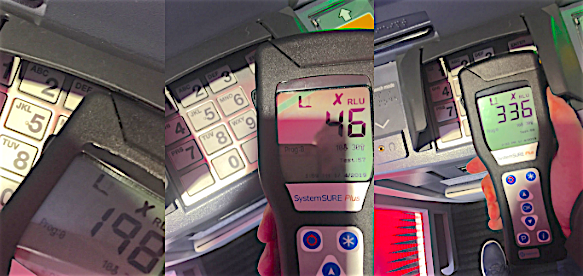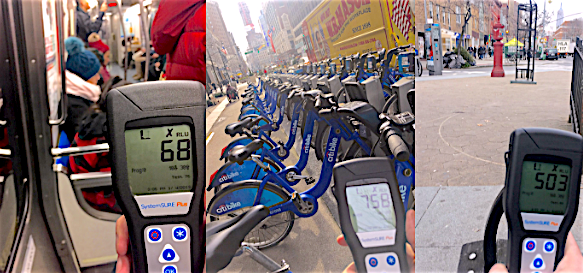ATMs have become an integral component of modern-day personal finance; even as cash becomes less and less common, nearly everyone still uses an ATM on a regular basis.
Being as popular as automated teller machines (ATM) are, you could only imagine the daily trials and tribulations that these machines must go through.
All of the dirty fingers touching the screen and keypad, the money being dispensed that has changed hands thousands of times, and the debit cards that have been swiped and dropped just about everywhere all suggest that ATMs are quite filthy.
Now imagine an ATM in the heart of New York City, one of the densest and most traversed areas in the world. It surely has to be incredibly dirty, right?
As we always do, LendEDU worked to collect some data to answer this question to figure out just how dirty NYC ATMs really are.
Using the Hygiena SystemSURE Plus, a handheld hygiene testing device that measures bacteria on a given surface and provides realtime results, LendEDU walked through New York City from Times Square to the West Village testing multiple parts of 20 different ATMs and then compared the cleanliness of the ATMs to other dirty things in the city, like a subway pole.
The results may make you want to limit how many times you use ATMs from here on out.
A Quick Explanation…
So, how did we go about testing various New York City ATMs for their level of filth? As mentioned above, LendEDU used the Hygiena SystemSURE Plus to conduct the surface testing. As part of this testing, Hygiena provided test tubes that each included a cotton swab to be used on the ATMs.
At each of the 20 New York City ATMs, three parts of the machine were tested for their cleanliness: the keypad, touchscreen, and card reader. Each of these components at each ATM were swabbed; the swab is then dropped into the SystemSURE Plus, which returns a cleanliness score in 15 seconds.
Specifically, the SystemSURE Plus is testing for adenosine triphosphate (ATP), the universal unit of energy in all living cells. Detecting for ATP is one of the leading methods recommended by the Center for Disease Control (CDC) for monitoring and improving cleanliness in hospitals.
ATP is measured in relative light units (RLU), and the higher the RLU, the more ATP there is on a surface, or the more dirty the surface is.
For reference, Hygiena’s website has the pass limit for a food service establishment’s surface at 10 RLU or less. In an operating room, the pass limit is also 10 or less RLU, while a public area has a pass limit of 50 RLU. So if the SystemSure PLUS returns a reading of 15 RLU at the table of your favorite restaurant, it is considered too dirty to eat there.
Comparing All 20 ATMs Against Each Other
For this study, LendEDU tested 20 different ATMs throughout New York City; 10 were located in and around Midtown and Times Square, a high foot-traffic area, while 10 were located in and around West Village, a low foot-traffic area for New York City standards.
At each ATM, three different parts of the machine were tested using one swab for each different part. The three parts were the keypad, touchscreen, and card reader.
In the far right column of the table below, the average cleanliness score at the ATM is listed. This was found by adding together the respective scores for the three components and dividing by three.
Interestingly, the clear majority of ATMs seemed to follow a particular pattern in terms of cleanliness; in all but seven of the ATMs tested, the card reader was the dirtiest component, followed by the keypad, while the touchscreen was the “cleanest” of all three.

When one thinks about all of the places an ATM card has been swiped and touched, it makes sense that this would be the dirtiest part of these machines. Further, this part of the ATM is the least likely to get cleaned compared to the touchscreen or keypad.
Recording a score of 943 RLU, the card reader at West Village ATM 6 was the most unsanitary of any surface tested throughout the day. Conversely, the touchscreen at West Village ATM 2 was the cleanest of all surfaces tested during the course of the day, registering at 30 RLU.
The filthiest keypad belonged to West Village ATM 5 (471 RLU), while the most germ-ridden touchscreen was found at Midtown/Times Square ATM 6 (627 RLU). Overall, West Village ATM 2 was the cleanest (109 RLU), while the Midtown/Times Square ATM 6 was the dirtiest (513 RLU).
The biggest takeaway from this section of the study? ATM cards are carrying a whole mess of germs.
Comparing the Average Enclosed ATM to a Street ATM
Using the data we compiled for the 20 enclosed ATMs throughout New York City, we were able to come up with the average RLU for the three parts of the ATM and the overall average RLU.
Other than those 20 ATMs and some New York City items, which we will get to later, we also tested one of those outside ATMs that you can find on pretty much any New York City sidewalk. These ATMs are not affiliated with any bank, but rather operated by a third party vendor.
So, how do those third-party ATMs stack up against the traditional, indoor bank ATM in terms of cleanliness?
Not surprisingly, the street ATM (318 RLU) was quite dirtier overall when compared to the average indoor bank ATM (286 RLU). The third-party ATM had a more filthy keypad and touchscreen especially, with the latter recording a score of 532 RLU.
Interestingly, however, the average bank ATM card reader (423 RLU) was significantly more grimy than the outdoor ATM card reader (142 RLU). This could simply be because the bank ATMs are used at a much higher rate than those ATMs you can find on the sidewalk.
Comparing High Traffic ATMs to Low Traffic ATMs
One of the variables we wanted to compare was whether the ATM was in a high traffic area or low traffic area.
To do this, we tested 10 ATMs in and around Times Square, perhaps the most tourist-laden area in the Big Apple, and 10 ATMs in West Village, a part of the city not nearly as crowded.
As the graphic above depicts, high traffic ATMs on average were dirtier across the board when compared to low traffic ATMs.
Since there are more people frequenting Midtown and Times Square, there are likely more cards being swiped and more fingers touching the keypad and touchscreen than there is for an ATM located in West Village.
Comparing NYC ATMs to Infamously Dirty Things Around Manhattan
It is quite evident that ATMs, especially ones in New York City, are incredibly disgusting just by reading some of the figures in this report.
However, what do we have as a benchmark to compare the cleanliness of New York City ATMs to? Luckily, there are plenty of filthy things in the city so this came pretty easily to us.
As part of this study, LendEDU tested nine different things in the Big Apple that are known to be germ-infested, like an escalator in Penn Station, a parking meter, and a subway ticket machine.
ATMs cannot possibly be dirtier than some of those things, right?
While the average cleanliness scores for the different parts of an ATM and the overall average score were not as bad as some New York City germ magnets, the comparison results were not comforting either.
All components of the average New York City ATM were still dirtier than things like a WiFi hub or a public bathroom handle in Penn Station. Additionally, it is important to remember that we used the average ATM cleanliness scores for these comparisons; using individual scores is a whole different story.
For example, the card readers at West Village ATM 6 (943 RLU) and Midtown/Times Square ATM 9 (858 RLU) were dirtier than any New York City object tested, including the handles on a CitiBike (758 RLU), a McDonald’s door handle (664 RLU), and a subway ticket machine (599 RLU).

Interestingly, the touchscreen at Midtown/Times Square ATM 6 (627 RLU) was more germ-ridden than the touchscreen for the subway ticket machine (599 RLU). Further, the dirtiest overall ATM, Midtown/Times Square ATM 6 (RLU 513) was filthier than things including a park bench (503 RLU) and a NYC parking meter (473 RLU).
For reference, please see the table below to see the cleanliness score for all of the New York City objects we tested.
Alternatives to Using an ATM
If you’re feeling a bit skeptical about using ATMs after taking a look at some of this data, don’t worry—there are alternatives to using one.
LendEDU lists a few below.
Credit Card
This is perhaps the most common alternative to using an ATM and cash. There are countless credit cards out there, so you shouldn’t have any trouble finding one that’s right for you.
When applying for a credit card, your current financial situation and your credit score will have a big impact on the credit card interest rate and terms you ultimately receive.
Methodology
All results seen within this report come from a project that was completed by LendEDU on January 4th, 2018. During that date, LendEDU went throughout New York City and tested three different components at 20 different ATMs throughout the city. Additionally, one street ATM and nine different New York City objects were also tested on the same day.
LendEDU’s cleanliness score derives from the RLU readings from Hygiena’s SystemSURE Plus handheld device. The device tests for ATP and gives the user an RLU reading within 15 seconds. For each surface tested, a Hygiena cotton swab was used to wipe the respective surface. That cotton swab was then dropped into the SystemSURE Plus, which returns an RLU reading in 15 seconds. That RLU reading is the basis of the LendEDU cleanliness score. A higher RLU reading meant the surface was more dirty and covered in more bacteria and vice versa.
To calculate the average overall cleanliness score for a respective ATM, all three RLU readings for that ATM were added up and divided by three. To calculate the average cleanliness score for the various components, all cleanliness scores for that component at each ATM were summed together and divided by 20.
In terms of the ATMs tested, we split the ATMs evenly between high traffic ATMs located in and around Times Square and low traffic ATMs located in and around West Village. To develop the average scores for the high traffic and low traffic ATMs, the various scores from the respective ATMs were added together and divided by 10.
See more of LendEDU’s Research
About our contributors
-
 Written by Mike Brown
Written by Mike BrownMike Brown uses data from surveys and publicly available resources to identify emerging personal finance trends and tell unique stories.